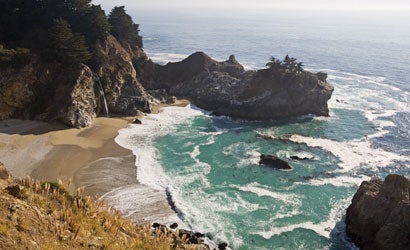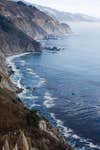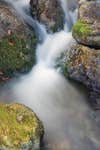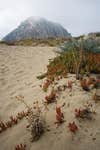Big Tips in Big Sur
A How To Guide to One of California's Greatest Landscapes.

The 90-mile stretch of rocky cliffs and breaking surf known as Big Sur, located between Los Angeles and San Francisco, unveils itself gradually along the twisting curves of Highway 1. One only needs to stand along the road’s edge to be reborn among the rugged and desolate beauty of the region. Unfortunately, the jagged coastlines of Big Sur also pose unique photographic challenges. During my two-day visit I grappled with a thick fog that broke only during the harsh light of midday. I was forced to change my approach and my style of photography.
The old advice for shooting landscapes: shoot in the late evening and early morning when the light is soft and beautiful, works well in ideal situations. Pictures seem to take on a luminous quality during these periods, with the “magic hour” often starting before the sun has even risen, and in the evening, ending a half hour after it’s set. These are prime times to shoot, the light is directional, yet still soft and pleasing, and even the colors are more saturated, with warms hues bathing everything. I had gone to Big Sur with these images in mind but unfortunately, the thick fog made those shots nearly impossible.
See the Image Gallery for technical information on these shots and more photos from Ian’s trips to Big Sur.
Related: Ian Frazier’s Pacific Beach Photo Gallery.
To see more of Ian Frazier’s work check out his website iansfrazier.com.
Mid-day and the Beach
| © Ian Frazier |
| Click photo for larger image. |
This photograph was taken at Pfeiffer Beach, one of the few beautiful stony beaches that is relatively easy to get to and has some interesting rock formations. I usually avoid taking midday photos, but after a frustrating morning I was desperate to shoot anything. The problem with shooting at noon on a clear day is that the light is harsh and white. Colors will often seem washed out, shadows turn to black, and whites are easily blown.
What drew me to this area wasn’t the light, it was the character of the beach. The way that the boulders in the foreground carried my eyes into the picture while providing a natural frame for the beach was the main consideration when framing this photograph. I also liked the soothing earth tones and bright sky lending a happy light feeling to the image. The few wispy clouds completed the idea that this was a nice day on a nice beach.
How I got this shot:
1. I selected a small aperture (f/20) in order to keep the whole scene in focus. Initially, I focused on the closest rocks, I then adjusted the point of focus to be slightly past the closest thing I wanted in focus. By doing this I maximized the depth of field (or the area that would appear sharp) in the image.
2. I used a circular polarizer to help tame the glare bouncing off of the wet rocks, and saturate the colors. Because I was using such a wide lens (17-40 on full frame) I chose a thin polarizer which lowered the chance of vignetting, and I rotated the filter until I cut the glare without over-polarizing the sky and turning it an unnatural blue. The polarizer also helped to bring the clouds out and decreased the detail robbing reflections of the water.
3. I shot at 1/30 sec, knowing that the meter would account for the loss of light (around 1 stop) caused by the polarizer. Without a meter, the sunny 16 rule (at f/16 the shutter speed is around 1/the ISO) would have worked equally as well, and a little mental gymnastic proved this.
Where to position the sky was important, and for this photo the interest lay in the rocky foreground not the bland sky. By putting the horizon near the top third, I allowed the viewer’s eyes more room to travel, and avoided the usual boredom of a centered image. This is a rare image where I think the harsh light and contrast shadows worked well, emphasizing the rocky subject of Big Sur’s coast.
Seeing the Forest from the Trees
| © Ian Frazier |
| Click photo for larger image. |
Careful planning will only take you so far, sometimes the weather has other ideas. I had originally gone to Julia Pfeiffer-Burns State Park with the idea of shooting its tranquil cove at daybreak. Instead I got thick fog. Luckily, I also got this picture.
This photograph happened because I was in the right place at the right time. The sun had just crested the hills behind me, and for a few brief minutes, its light shone magically through the morning mist. The eerie light lit the path in front of me, and I knew I had to shoot fast.
How I got this shot:
1. Framing this photo was difficult. I knew that the backlit fog and trees would be my main subject, but worried that it would lack context if taken as a vertical picture, and I didn’t want the glowing light to overwhelm the image. Instead, I used a wide 24mm focal length to bring the glowing light, the lit path, and misty fog into the frame. By doing this, I was able to use the light tones of the unlit fog in the right hand corner to balance image, and further emphasize the mystical quality of the light. A wider angle also let me use the nearby tree branches as a natural frame, keeping the viewer in the picture.
2. Metering was also a challenge. Strong bright areas can often fool a meter, causing important subject detail to be underexposed. In this case I knew that the dark foreground and the lighted mist would balance out, and matrix or patterned metering worked well. Had the bright areas been larger I would have instead spot metered the nearby tree trunk, knowing that I wanted that to be my mid-toned value. Luckily, technology sometimes makes things easier, and as a double check, I examined the camera’s LCD to make sure that the image was properly exposed and I had reached the best compromise between the shadows and highlights.
| © Ian Frazier |
| Click photo for larger image. |
One way to beat the harsh light of midday is to change your expectations. Even though I was at Big Sur, an area known for it’s amazing coastline, it was almost impossible to take a good landscape photo. The sky was too bright and the shaded cliffs too dark. Instead, I switch my attention to shooting close-ups and hiked back into the wooded areas.
To make this photo of the small stream, I looked for a spot that was surrounded by trees and shaded from the glaring sun. The soft filtered light gave a much more pleasing saturated image, with smooth tonal gradations that enhanced the stream’s feeling of calm. Unfortunately, the first few photos I took failed to express these feelings. I had made a common mistake of trying to include too many elements into a photograph. Too often people will slap on the wide-angle lens and start shooting. In this case I had the stream (which was nice), but I also had a bunch of dead sticks and logs, an old rusted tire, and a jumble of brown leaves detracting from the calm simple picture that I wanted.
How I got this shot:
1. I zoomed out to 70mm and knelt down closer, effectively removing all the distracting elements and focusing on the prettiest part of the stream. I looked for a composition that showed the flowing water, using the wet rocks as a natural frame to emphasize its sinuous nature. I had to play with several angles and compositions before getting this one.
2. To blur the slow moving water I needed to use a shutter speed of 6 seconds. A tripod was a must, and for anything under 1/30 of a second I use the mirror-lockup option as well. In fact I keep the custom function on my camera (canon 5D) preset for mirror-lockup to save time.
3. Getting such a slow shutter speed was something of a challenge, even in the shade. I used a circular polarizer to reduce the light by a stop and remove the glare from the wet rocks, creating a more saturated image. I also shot at 70mm to compress the scene slightly and then stopped down to f. 20 to capture detail across the scene. The small aperture also increased the exposure time, until the water was a pleasing blur.
4. To determine exposure I relied on the cameras pattern metering. The equal amounts of dark rocks and light water, as well as the softer light meant that I could trust the meter’s reading, and a quick check of the histogram showed that none of the whites had been blown.
Morro Rock
| © Ian Frazier |
| Click photo for larger image. |
Not quite in Big Sur, but a nice stop along the way is Morro Bay. This little ocean-side town is home to the impressive Morro Rock, an ancient volcanic plug which sits at the mouth of the bay. I came upon this scene on my way to Big Sur, and again faced the blah light of a foggy morning.
How I got this shot:
1. I setup this shot from behind a sand dune, to avoid the crowded parking lot and milling people. It also let me fill the frame with the interesting dune vegetation and minimize the amount of featureless foggy sky in the photo. I adjusted the tripod legs to fold out almost flat, and using a wide angle lens (17-40mm) I got down close to the dune.
2. I shot at 21mm, which was wide enough to capture the whole scene without looking overly distorted. The wider angle also meant that I didn’t need to stop down as much (f.14) to get a nice depth of field, letting me avoid some of the sharpness robbing diffraction associated with smaller apertures. Because the sky was overcast, it acted like a giant soft box, illuminating the rich colors and details of the grasses. The low contrast light also made metering simple with a shutter speed of 1/40 at f.14.
I chose this composition as the foreground vegetation added color and helped to bring the viewer into the scene. When making a photograph like this I know that the details in the foreground need to be sharp, allowing the viewer to easily move from one object to the next.
I was also glad that I brought my ball-head and tripod since it allowed me to get down in the sand, and quickly adjust from vertical and horizontal. I was careful though about not getting the tripod’s legs in the photo, sometimes a difficult task with extreme wide angle lenses.
Misty Coast
| © Ian Frazier |
| Click photo for larger image. |
I like trying to photograph impressive landscapes; images where the eye delights in the plethora of detail and colors, but I also recognize the importance of simplicity. Sometimes the most powerful images are the ones that reach out and grab the viewer. With people, we often remember the details that make them unique: a crooked smile, the way their hair looks in the morning, or the curve of their back. The same can be said for landscapes.
I was frustrated that the clouds and fog prevented me from taking the sweeping coastal view that I had planned from my stop on Highway 1. Instead I focused capturing the feeling of the place. In this image I wanted to play with the graphical elements in the frame. The bright fog bank and the dark rolling coast created an interesting balance of tones, an image that seemed almost black and white. When I squinted into the scene, I realized that the image I wanted to make was one of contrasting shapes and diagonals, with the coast layering gently into the distance.
How I got this shot:
1. To capture the image, I switched to a longer lens (70-200mm). At 70mm I compressed the scene without zooming in too much and losing the needed foreground. By leaving the nearby ridge I gave shape to the cloud bank while providing interesting details. It also repeated the triangular shapes of dark and light areas. Often the repetition of patterns in nature can create a more visually arousing photo. In this case it was the diagonal cliffs receding into the distance.
2. The exposure of this scene was tricky. The image was basically a study of contrasting tones, with the brightly lit fog going almost white in the harsh afternoon light. I stopped the aperture down to f.16 to capture the whole scene in focus, but in this case the “sunny 16” rule left me with blown highlights, and I lost the subtly gradations of light tones. Instead, I underexposed by one stop giving me a shutter speed of 1/200. Details in the darker areas could be lifted in Photoshop, but lost highlights would be unrecoverable and especially glaring.
3. This was also one of those rare photographs where I didn’t use a tripod. Instead I relied on the lens’ image stabilizer and a fast shutter speed (which was over the standard 1/focal length) to keep the image sharp. By hand-holding the lens I gained a lot of freedom to frame the image quickly without losing too much in quality.
Big Sur Bridge
| © Ian Frazier |
| Click photo for larger image. |
I’ve never seen fog move so quickly — within the span of a few minutes the sun was blotted. It billowed up the side of the cliffs, reducing the visibility to almost nothing. It also ruined any chance at an inviting evening scene or a gorgeous sunset.
To make this photograph of Bixby Bridge I worked with the fog to create a moody image of a popular Big Sur spot.
How I got this shot:
1. I used a wide angle 24mm focal length to include some of the foreground and the distant bridge. The diagonal foreground leads the eye towards the bridge and shows the vegetation of the area. The grasses also add a little color to an otherwise monochrome scene.
2. At the time that I took the photograph, the light was low and a slow shutter speed of 1/6 was required. I could have opened up the aperture from f.16, but would have risked losing foreground detail, and I wanted maximum depth of field. Instead I relied on my favorite accessory, the tripod. On loose terrain it’s especially important to make sure the tripod’s legs are stable, since nothing ruins a trip more than watching your camera tumble down a hill. Because the shutter speed was under 1/30 of a second I worried about vibrations from mirror-slap and even slight ones caused by pressing the shutter. I solved this by using the mirror lockup with 2sec delay. For stationary subjects this function can be an image saver.
3. This image also required careful metering since fog can easily fool a camera’s meter. Cameras like 18% gray, nothing would make them happier than a medium toned world. When we see fog, especially backlit scenes, it looks light and ephemeral. The meter instead thinks that the scene is over-exposed and wants to make this same fog a blah gray. To keep the light feeling of foggy scenes, overriding the meter is necessary and experimentation is often the best way. I find that anywhere from a half to one stop seems to work best, but bracketing in both directions will almost guarantee a usable image. It’s also important to remember that foggy conditions will destroy fine details in a scene, and flatten the contrast.

Location-Pfeiffer-Beach-Tech-Info-Canon-5D.-Exp

Location-Scene-from-Julia-Pfieffer-Burns-State-Pa

Location-Point-Sur-Light-Station-Tech-Info-Trip

Location-View-of-Bixby-Bridge-Tech-Info-Tripod

Location-Julia-Pfeiffer-Burns-State-Park-Tech-In

Big-Sur-California

Big-Sur-California

Big-Sur-California

Big-Sur-California

Big-Sur-California

Location-Julia-Pfeiffer-Burns-State-Park-Tech-In

Location-Partington-Cove-Tech-Info-Tripod-mount

Location-Morro-Bay-Tech-Info-Tripod-mounted-Can

Location-Big-Sur-Coast-Highway-1-Tech-Info-Cano

Location-Bixby-Bridge-Tech-Info-Tripod-mounted

Location-Big-Sur-Coast-Highway-1-Tech-Info-Trip

Location-McWay-Creek-Falls-Tech-Info-Tripod-mou

Location-Bixby-Bridge-Tech-Info-Tripod-mounted